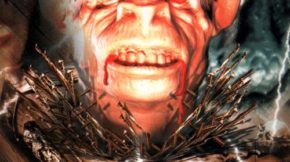The Summer of 1977 was the era of disco, bell bottoms, and questionable haircuts. My brother, the walking-talking Bollywood encyclopedia, and I went from our suburban haven to the bustling Tooting High Street in South London. This wasn’t our first rodeo. We had made this journey countless times before, usually on Sundays, to catch the local cinemas’ 2-for-1 deal on the latest Bollywood flicks, fresh off the presses from Bombay. We were young, reckless, and armed with nothing but a thirst for adventure and a deep love for Hindi cinema. It was the Summer of Sam, the best and worst of times; wait, scratch that last part. All in all, it was a pretty sweet summer.
On this lazy summer afternoon, the target was to be the latest Dev Anand – Zeenat Aman starrer by the name of Kalabaaz. I wasn’t that old yet, but I was old enough to know that Dev Anand was going through an awkward phase in his career where he was trying to somehow stay relevant in romantic lead roles in an era increasingly dominated by the “Angry Young Man” persona post-Zanjeer and Sholay. The gentle romantic age of the 50s and 60s was making way for a new king of heroes, and Dev Anand struggled to fit in. Still, he had enough clout in the industry to create movies tailor-made to highlight his considerable charm and talents.
I must admit that Zeenat Aman, after the stunning entry in Hare Rama Hare Krishna and Yaadon Ki Baaraat, was far more the reason I must have tagged along because when it came to Dev Anand movies, they tended to be more misses than hits in my opinion. Still, you never knew what to expect, so I was not thrilled but somewhat okay with the prospect. I was not thrilled because there was no Bindu, no Aruna Irani, no Faryal, no Jayshree T, no Padma Khanna to spice things up and a film called Kalabaaz set to the backdrop of a circus with our two lead stars as trapeze artists just sounded a little off-putting. Also, the Soundtrack was by Kalyanji-Anandji, who were not our favourites by a long shot.
We made it safely through to the end of the film, and though we dismissed it as a massive pile of cow dung, something about it stayed with us, lingering on like a fungus that continued to grow and grow.
Indeed, there are few movies so endearingly remembered as this one and 38 years later, goaded on by Todd Stadtman’s excellent book on Bollywood 70’s films, “Funky Bollywood”, we have both been compelled to dig it out and revisit this experience and rediscover precisely why it has lived so close to our hearts. Did it have an “X” factor, or does it need to be exorcised from memory, expunged and demoted from the “cult classic” status we had acclaimed the movie as?
The opening scenes are set in an apartment supposedly in Hong Kong, establishing that Zeenat Aman’s character is an utterly devout follower of Radha Krishan; her life revolves around this faith. Also shown is that Radha (Zeenat Aman) is a supremely confident trapeze acrobat, just like her father had been before her. It also establishes her father as a highly snazzy dresser but an emotional wreck. Pradeep Kumar breaks down sobbing at the mere mention of his beloved late wife.
The opening scene also quickly establishes why Zeenat Aman, trying as though she might (Satyam, Shivam Sundaram, anyone?), was often worse for trying to be natural; it just didn’t happen for her. That said, she fizzles in movies like Don despite her histrionic limitations. Here, she is perfectly adequate, considering the material she has to work with. Zeenie Baby is on auto-tune mode, which some might say is not a bad thing.
Daddy Pradeep Kumar decides it is time to see the fuss about this Raymond Circus, which is increasingly popular in Bombay and claims to have an ace trapeze artist, perhaps even better than Radha. Plans are made to visit the homeland shortly. Still, they are abruptly hastened to an immediate departure because that night, Radha has a dream in which some mercenaries make off with the glittering trophy that is the golden Radha Krishan statuette at the Mandir presided over by Pujari ji A.K. Hangal, who remarkably looks in 1977, precisely the same as he did in 1971 or even 1991 for that matter. A. K Hangal was a man who was typecast and thus specialised in playing elderly family figures for an entire career. It was quite a shock to discover later that many of his movie sons were around the same age as A.K. Hangal. Here, he plays the Pujari ji of the Radha Krishan temple, a benign saffron-robed figure adored by one and all and fearless in his faith despite the menace of mercenaries in the region sniffing gold. The Radha Krishan Murti (Statuette) is, of course, solid gold.
After Radha’s premonition, suitcases are hastily packed (and you can almost hear an adoring father telling his daughter not to forget to pack her niftiest trapeze artist costumes), and they fly off home.
Radha is right at home at the Raymond Circus, where her father arrives to negotiate for Hong Kong dates in the future. Behaving like Alice, lost in her magical world, Radha laps up the circus atmosphere, cooing at the animals and skipping around merrily until suddenly Balam, a leopard, escapes its cage and menaces her. Just as it is about to eat her (I have never seen a leopard attempt rape in a Bollywood movie, so I am assuming). Vijay acrobatically and heroically saves Radha from the jaws of death, fighting off the beast much to the delight of a gushing Pradeep Kumar, who is in an emotional meltdown mode again: “agar meri bachchi ko kuch ho jata to…” (you can complete the sentence with several suitable bolly-cliches.) The dashing Vijay of the slightly outlandish outfits is the trapeze master that Raymond Circus has built its reputation upon.
Soon, a romance kicks off between the trapeze artists amidst the charming backdrop of the circus, filled lovingly with oddities though not entirely on the Freak’s level A midget or two, an elephant, a clown here and there, a woman who lifts weights with her braid, and the cheetahs and stunted dwarf bears, a unique species predominantly found only in Bollywood movies. Love blossoms despite the opposing feelings the two trapeze masters have regarding faith; Radha is a total devotee, whilst Vijay scoffs at the superstitious ways of religion.
One night after a date, they return home to the circus, and a creature once again menaces Radha. This time, it’s a Dwarf Bear with more on his mind than just flesh for eating. He grabs hold of Radha’s clothes and swiftly removes the entire sari as she flees in horror again; her family’s honour is at stake. Fortunately, she soon finds the arms of her saviour, the non-believing but still charming elderly Vijay. Whatever they are doing to these animals at the Raymond Circus, it’s not healthy. Girl Crazy Dwarf Bears are not something to be taken lightly.
A bond is forged between them, and they reveal their intentions for one another to Daddy Pradeep, who goes into a frenzy of delight, reliving his past glories. He gushes his approval despite the somewhat less than luxurious living conditions at the circus, where one presumes his daughter will be living shortly.
There is another astonishing romantic interlude where the two trapeze artists fly hundreds of feet above the earth, holding on to one another and acting coy and flirtatious mid-air. Breath-taking scenery with a surreal touch, you soon realise that the background swings from side to side and that the trapeze artists are still somewhere in Filmistan Studios! Once again, there are superb and dizzying special effects for this illusion that totally backfires yet still looks spectacular and so brazen that you must admire it for its utter ineptitude and gall. An unlikely homage to TV’s classic Adam West version of Batman? Doubtful.
Daddy Pradeep is over the moon at the news of Radha and Vijay’s upcoming marriage, especially as he and his wife had also been trapeze artists and had fallen in love the same way. In his exuberance, he boasts to Radha and Vijay about the “Shadow Jump” that he would perform with his wife, which only the highest-skilled acrobats can achieve. Radha intervenes, reminding him that she had completed the famed jump at age 11, and Vijay is momentarily shown up as being just a little behind the times. Still, it’s natural, considering his advanced age. From this boasting session emerges the challenge of performing The Shadow Jump. Radha and Vijay avidly take up the gauntlet with a giggling father nodding his approval and encouragement.
A few nights later, Radha announces to an excited crowd that tonight she will be performing the “Shadow Jump” with her partner Vijay, and to make it even more daring, she orders the safety nets to be removed. Then fate strikes a cruel blow just before the stunt. Vijay’s Radha Krishan amulet, the one Radha put around his neck, unknowingly falls to the ground. Not a good omen at all, and so it proves. Moments later, Vijay fails to clutch onto Radha, who plunges to her doom and almost certain death. There is further bad news when it is learned that Pujari ji has been abducted and the blessed golden God Statues stolen in the village.
Miraculously, Radha survives the fall, but she has to pay a heavy price as the doctor informs her father that she will now be “ugly forever”, but he also says that plastic surgery is making tremendous advances. Maybe there will come a time when they can restore at least some of her previous beauty. Radha decides that having an ugly wife for Vijay would be his ultimate humiliation and that he deserves better. So, she quietly slinks off into the dark, leaving him to discover the power of Radha Krishan and thus find his faith.
Vijay sets off with his best friends from the circus, and soon they discover the old Pujari ji, who tells Vijay as he breathes his last few breaths that he has hidden the golden Murtis deep inside a ravine and that Vijay must go and bring them back safely and restore them to the place at the temple. Unfortunately, the Pujari’s directions are rather daunting and amount to traversing several mountains, valleys, gorges, caves, canyons, and waterfalls; this will be a long haul. Meanwhile, Radha has vanished into thin air. The film now takes on the shape of a treasure hunt cum obstacle course pitted against the odds and some pretty formidable customers, such as the notorious and much-feared character everybody refers to in hushed voices as Kimong.
The race is on to find the Murtis, but who will get their hands on them first, Kimong and his henchmen or Vijay and his brave companions? Kimong intends to melt the statuette and sell it as gold on the black market, while Vijay has only noble intentions. And remember, whenever Sujit Kumar is in the cast, you know there will likely be some shifty business along the way.
There is a series of comedy-tinged fight sequences, a magnificent appearance by Kimong, and a dance by Ambika Johar as his moll. Later, Radha does recover her beauty and returns to the fold, but with her plan to test her future husband’s devotion. There are some dazzling sets along the way and some awe-inspiring special effects, notably the flying torch that puts paid to a whole bunch of astonished goons in one short but telling flight. Plenty of hair-raising moments along the way, and Radha’s faith is set to the ultimate test in a breath-taking climax. Who will prevail amidst the mayhem? That is the question, oh and wait, what’s this? An Avalanche?
Kalyanji- Anandji’s compositions are routine, with Kishore Kumar trying hard to sound enthusiastic while Dev lip syncs to his “Roothe Hain To Maan Jayengay”, riding an elephant no less. However, with the fight and action music, Kalyanji-Anandji show their class with a blistering adaptation of Giorgio Moroder’s Love to Love You Baby bassline being given a fabulous Bolly-jazz-funk makeover. Exquisite. The designers of the various outfits in the film, especially those responsible for Dev Anand’s array of delightfully coloured dungarees and matching cap suits, must be mentioned here for having done a sterling job. Some of the left-over cloth is seen put to good use as one or two of Radha’s outfits, so a job well done.
In retrospect, the story’s moral is to try not to be too boastful when having bragging conversations that develop into challenges with the stakes too high to back down, like the Cuban Missile Crisis. The other more obvious moral is making sure you don’t carelessly drop your religious baubles before you attempt some daredevil stunt. There are important lessons about faith, trust, love, The Shadow Jump, and dwarf bears along the course of this quite fascinating movie—essential viewing for all.





















